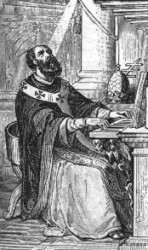 Like his predecessor St. Agatho, Leo II was a Sicilian. Elected shortly
after the death of Agatho, Leo was not consecrated for over a year and a
half. The reason for this odd delay is not evident, but it may have been
due to negotiations regarding imperial control of papal elections. Pope
Agatho had been engaged in these negotiations and Constantine the Bearded
had already promised to abolish or at least reduce the tax which for some
time now popes had been compelled to pay to the imperial government at
their consecration.
Like his predecessor St. Agatho, Leo II was a Sicilian. Elected shortly
after the death of Agatho, Leo was not consecrated for over a year and a
half. The reason for this odd delay is not evident, but it may have been
due to negotiations regarding imperial control of papal elections. Pope
Agatho had been engaged in these negotiations and Constantine the Bearded
had already promised to abolish or at least reduce the tax which for some
time now popes had been compelled to pay to the imperial government at
their consecration.
Leo II was a man learned for his time who knew Greek and was an orator of
some polish. Virtuous too, he was a lover of poverty and very good to the
poor. Highly esteemed by his contemporaries, he is considered a saint by
the Church.
Though his pontificate was quite short, Leo did accomplish something. Since
St. Agatho had died while the Sixth Ecumenical Council was still in
progress, it was Leo who received the decrees of this council. He confirmed
them with pleasure. He accepted the inclusion of Pope Honorius among those
condemned for the Monothelite heresy, but made it clear that Honorius was
condemned not for teaching heresy, but for allowing it to spread by his
negligence. Leo wrote to the bishops of the West publishing the decrees of
the council, and explaining the condemnation of Pope Honorius. Since the
Monothelite heresy had never been popular in the West, there was no
difficulty in getting the West to accept these decrees.
At this time Leo put a period to the attempt of the Ravenna archbishops to
get away from the control of the Bishop of Rome as primate. The friendly
Constantine the Bearded revoked the decree of his father Constans in favor
of Ravenna. The kind Pope sweetened the matter for the Ravenna bishops by
abolishing the tax it had been customary for them to pay when they received
the pallium and by other concessions.
Probably because of Lombard raids, Leo transferred the relics of a number
of martyrs from the catacombs to churches inside the walls of the city. He
also dedicated two churches, St. Paul's and Sts. Sebastian and George.
St. Leo II died June 28, 683, and was buried in St. Peter's. His feast is
kept on June 28.
Excerpted from "Popes
Through the Ages" by Joseph Brusher, S.J.

